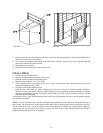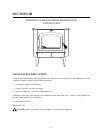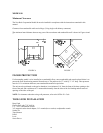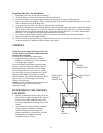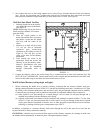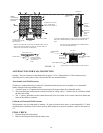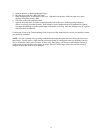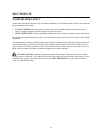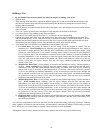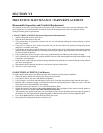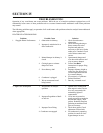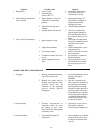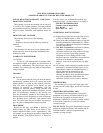
Problem
3. Backpuffing
4. Smoke Rollout when heater
door is opened
5. Low Catalytic Temperature
1. Plugging
2. Catalyst Peeling
3. Catalyst Masking
Possible Cause
1. Gusts of wind
2. Hot combustor
(Above 1400
o
F)
1. Bypass damper is closed, or
combustor is in operating
position
2. Wind gusts blowing down
chimney
3. Opening heater door too fast
1. Bypass damper is open
2. Light-off not obtained
3. Fuel charge is spent
4. Combustor coated with fly ash
or soot
5. Heater dampered down too
much
1. Burning materials that produce
a lot of char and fly ash
2. Burning wet, pitchy wood or
burning large loads of small-
diameter wood with the
combustor in the operating
position without light-off
taking place
1. Extreme temperatures at
combustor surface can cause
the catalyst to peel. Over-
firing and flame impingement
are primary cause
1. Not maintaining light-off
temperature
Solution
1. Install Buck draft inducer
2. Increase the amount of
combustion air slowly.
1. Open bypass damper. In
retrofit place combustor in
bypass position before
opening stove door.
2. Install Buck draft inducer
3. Wait a few seconds after
opening bypass damper be-
fore opening heater door to
give smoke a chance to exit
heater
1. Once light-off temperatures
have been reached and unit is
stabilized, close bypass
damper
2. Follow manufacturer’s oper-
ating instructions
3. Refuel as necessary for com-
bustor operation
4. See section on “Combustor
Related Problems”
5. Ensure that proper air mix-
ture and draft are available
for wood pyrolysis to con-
tinue
1. Do not burn materials such as
garbage, gift wrap or
cardboard
2. Burn dry, seasoned wood.
Don’t place the combustor in
the operating position until
high temperatures are high
enough to initiate light-off. It
may be possible to burn the
accumulated soot or creosote
off by putting the combustor
in a partially open-partially
closed position after a “hot”
fire has been started.
1. If peeling is severe, remove
and replace combustor.
Avoid extreme temperatures.
1. Place combustor in a partially
closed position after a “hot”
fire has been started to burn
soot off
COMBUSTOR-RELATED PROBLEMS
24



